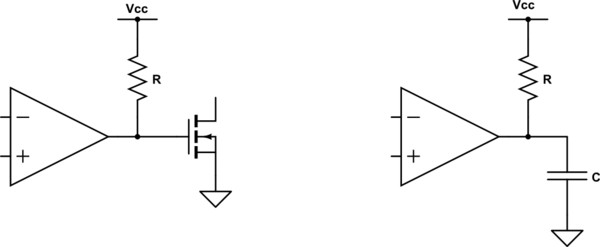A pull-up resistor is often used with a comparator’s open-collector output. But, is it always necessary? This article explores the role of a pull-up resistor in comparator circuits, examining factors like output transition speed, resistive loading, and choosing the appropriate resistor value.
Understanding the Need for a Pull-Up Resistor
Comparators with open-collector outputs can only pull the output voltage low. To transition the output to a high state, a pull-up resistor is required. This resistor provides a path for current to flow from the supply voltage (Vcc) to the output, effectively “pulling” the output voltage high when the comparator’s output transistor is off.
An open-collector comparator with a pull-up resistor and a capacitive load.
The pull-up resistor’s value influences several aspects of the circuit’s performance:
Output Transition Speed
The pull-up resistor and any load capacitance form an RC circuit that determines the output’s rise time. A smaller resistor value allows faster charging of the capacitance, resulting in quicker transitions from low to high. This is crucial when driving capacitive loads like MOSFET gates.
Resistive Loading and Output Voltage
The pull-up resistor also impacts the output voltage level when the comparator output is high. Consider a scenario with positive feedback for hysteresis:
Comparator circuit with hysteresis implemented using positive feedback.
In this configuration, the pull-up resistor forms a voltage divider with the feedback resistor. This can reduce the high-level output voltage, potentially preventing it from reaching Vcc. This voltage drop can be significant and might impact subsequent circuitry.
Choosing the Right Pull-Up Resistor Value for an LM393
Selecting the appropriate pull-up resistor involves balancing several factors. Using the LM393 comparator as an example, let’s examine how to determine a suitable resistance:
Minimum Resistance (Maximum Sink Current)
The datasheet specifies a maximum output sink current. Exceeding this limit can damage the comparator. The LM393 datasheet states a typical sink current of 16mA, but a worst-case value of 6mA. Using Ohm’s Law (R = V/I), with a 12V supply, the minimum resistance should be 2kΩ to ensure the current stays below 6mA.
Maximum Resistance (Output Leakage Current)
The datasheet also provides the output leakage current when the output is high. A higher resistance combined with leakage current can lead to a significant voltage drop across the resistor, lowering the high-level output voltage. While theoretically, a very high resistance might seem permissible based on leakage current at lower voltages, considering leakage at higher voltages (e.g., 30V) limits the maximum resistance to around 100kΩ to maintain a voltage drop below 100mV.
LM393 Datasheet provides detailed specifications.
Conclusion
A pull-up resistor is generally essential for comparators with open-collector outputs. Choosing the correct resistor value requires considering output transition speed, resistive loading effects on the output voltage, and the comparator’s datasheet specifications for sink current and leakage current. Balancing these factors ensures reliable operation and optimal performance. For most applications, a pull-up resistor in the range of a few kilohms to tens of kilohms is suitable. However, always consult the comparator’s datasheet and analyze the specific circuit requirements for the best results.
